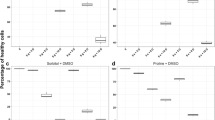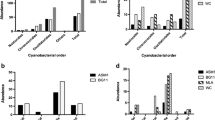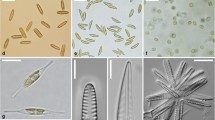Abstract
The Qatar University Culture Collection of Cyanobacteria and Microalgae (QUCCCM) is a unique resource containing a diverse collection of microalgae and cyanobacteria, isolated from the Qatar desert environment. In order to ensure maximum preservation of this resource, a number of cryopreservation techniques were applied to various strains, and the preservation effectiveness (cell viability and lipid productivity) was determined. The conditions tested were direct, passive, and freeze-cooling cryopreservation (technique), dimethyl sulfate and methanol (cryoprotectant), and 5 and 10 % cryoprotectant concentrations over storage durations of up to 1 year. It was shown that the cryopreservation regime is strain dependent, and strains belonging to the same genera can have different requirements. On the other hand, neutral lipid estimation, via Nile red fluorescence determination of pre- and post-cryopreserved microalgae isolates, confirmed that the lipid production is affected by the applied cryopreservation method.

Similar content being viewed by others
References
Abreu L, Borges L, Marangoni J, Abreu PC (2012) Cryopreservation of some useful microalgae species for biotechnological exploitation. J Appl Phycol 24:1579–1588
Benson EE, Bremner D (2004) Oxidative stress in the frozen plant: a free radical point of view. In: Fuller BJ, Lane N, Benson EE (eds) Life in the frozen state. CRC, Boca Raton, pp 206–241
Bodas K, Brennig C, Diller KR, Brand JJ (1995) Cryopreservation of blue-green and eukaryotic algae in the culture collection at the University of Texas at Austin. CryoLetters 16:267–274
Boroda AV, Aizdaicher NA, Odintsova NA (2014) The influence of ultra-low temperatures on marine microalgal cells. J Appl Phycol 26:387–397
Buhmann MT, Day JG, Kroth PG (2013) Post-cryopreservation viability of the benthic freshwater diatom Planothidium frequentissimum depends on light levels. Cryobiology 67:23–29
Calcott PH (1978) Freezing and thawing microbes. Meadowfield, Durham, UK, 68 pp
Canavate JP, Lubiant L (1997) Effects of slow and rapid warming on the cryopreservation of marine micro algae. Cryobiology 35:143–149
Chen W, Zhang C, Song L, Sommerfeld M, Hu Q (2009) A high throughput Nile Red method for quantitative measurement of neutral lipids in microalgae. J Microbial Methods 77:41–47
Day JG (1998) Cryoconservation of microalgae and cyanobacteria. CryoLetters 1:7–14
Day JG, DeVille M (1995) Cryopreservation of algae. In: Day JG, McLellan MR (eds) Cryopreservation and freeze-drying protocols. Methods in molecular biology, 38. Humana, Totowa, USA, pp 81–89
Day JG, Fenwick C (1993) Cryopreservation of members of the genus Tetraselmis used in aquaculture. Aquaculture 118:151–160
Day JG, McClellan MR (1995) Cryopreservation and freeze-drying protocols. Methods in Molecular Biology vol 38. Humana Press, Totowa, New Jersey, 245 pp
Day JG, Stacey G (2007). Cryopreservation and freeze-drying protocols (Vol. 368). Springer Science and Business Media
Day JG, Fleck RA, Benson EE (2000) Cryopreservation-recalcitrance in microalgae: novel approaches to identify and avoid cryoinjury. J Appl Phycol 12:369–733
Guermazi W, Sellami-Kammoun A, Elloumi J, Drira Z, Aleya L, Marangoni R, Ayadi H, Maalej S (2010) Microalgal cryo-preservation using dimethyl sulfoxide (Me2SO) coupled with two freezing protocols: influence on the fatty acid profile. J Therm Biol 35:175–181
Guillard RR, Ryther JH (1962) Studies of marine planktonic diatoms: I. Cyclotella nana Hustedt, and Detonula confervacea (Cleve) Gran. Can J Microbiol 8:229–239
Heckly RJ (1978) Preservation of microorganisms. Adv Appl Microbiol 24:1–53
Kuwano K, Saga N (2000) Cryopreservation of marine algae: applications in biotechnology. In: Fingerman M, Nagabhusha-nam R (eds) Recent Advances in Marine Biotechnology, Vol. 4, Aquaculture, Part A, Sea-weeds and invertebrates. Science Publishers, USA, pp 23–40
Mazur P (1963) Kinetics of water loss from cells at subzero temperatures and the likelihood of intracellular freezing. J Gen Physiol 47:347–369
McLellan MR (1989) Cryopreservation of diatoms. Diatom Res 4:301–318
Müller J, Day JG, Harding K, Hepperle D, Lorenz M, Friedl T (2007) Assessing genetic stability of a range of terrestrial microalgae after cryopreservation using amplified fragment length polymorphism (AFLP). Am J Bot 94:799–808
Nei T (1967) Mechanism of hemolysis of erythrocytes by freezing at near-zero temperatures: I. Microscopic observation of hemolyzing erythrocytes during the freezing and thawing process. Cryobiology 4:153–156
Piasecki BP, Diller KR, Brand JJ (2009) Cryopreservation of Chlamydomonas reinhardtii: a cause of low viability at high cell density. Cryobiology 58:103–109
Rastoll MJ, Ouahid Y, Martín-Gordillo F, Ramos V, Vasconcelos V, Del Campo FF (2013) The development of a cryopreservation method suitable for a large cyanobacteria collection. J Appl Phycol 25:1483–1493
Rhodes L, Smith J, Tervit R, Roberts R, Adamson J, Adams S, Decker M (2006) Cryoperservation of economically valuable marine micro-algae in the classes Bacillariophyceae, Chlorophyceae, Cyanophyceae, Dinophyceae, Haptophyceae, Prasinophyceae, and Rhodophyceae. Cryobiology 52:152–156
Stanier R, Kunisawa R, Mandel M, Cohen-Bazire G (1971) Purification and properties of unicellular blue-green algae (order Chroococcales). Bacteriol Rev 35:171–205
Tanniou A, Turpin V, Lebeau T (2012) Comparison of cryopreservation methods for the long term storage of the marine diatom Haslea ostrearia (Simonsen). Cryobiology 65:45–50
Tzovenis I, Triantaphyllidis G, Naihong X, Chatzinikolaou E, Papadopoulou K, Xouri G, Tafas T (2004) Cryopreservation of marine microalgae and potential toxicity of cryoprotectants to the primary steps of the aquacultural food chain. Aquaculture 230:457–473
Acknowledgments
This research was supported by Qatar Airways and the Qatar Scientific Technology Park (QSTP) and hosted by Qatar University. Very special regards go to the memory of Pr. Malcolm Potts who was always supportive and helpful.
Author information
Authors and Affiliations
Corresponding author
Rights and permissions
About this article
Cite this article
Saadaoui, I., Al Emadi, M., Bounnit, T. et al. Cryopreservation of microalgae from desert environments of Qatar. J Appl Phycol 28, 2233–2240 (2016). https://doi.org/10.1007/s10811-015-0743-x
Received:
Revised:
Accepted:
Published:
Issue Date:
DOI: https://doi.org/10.1007/s10811-015-0743-x




